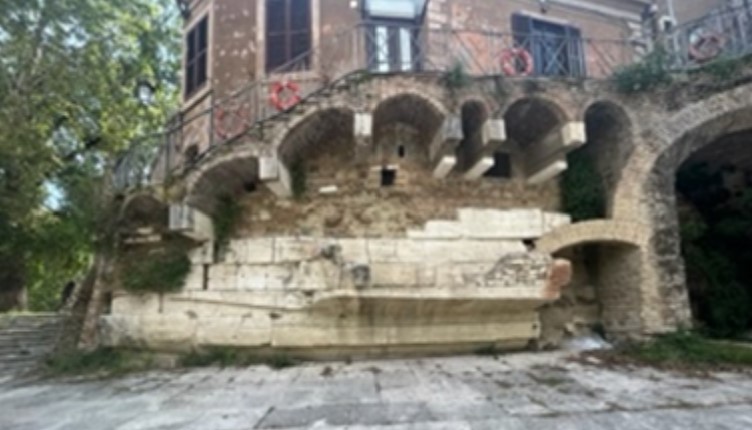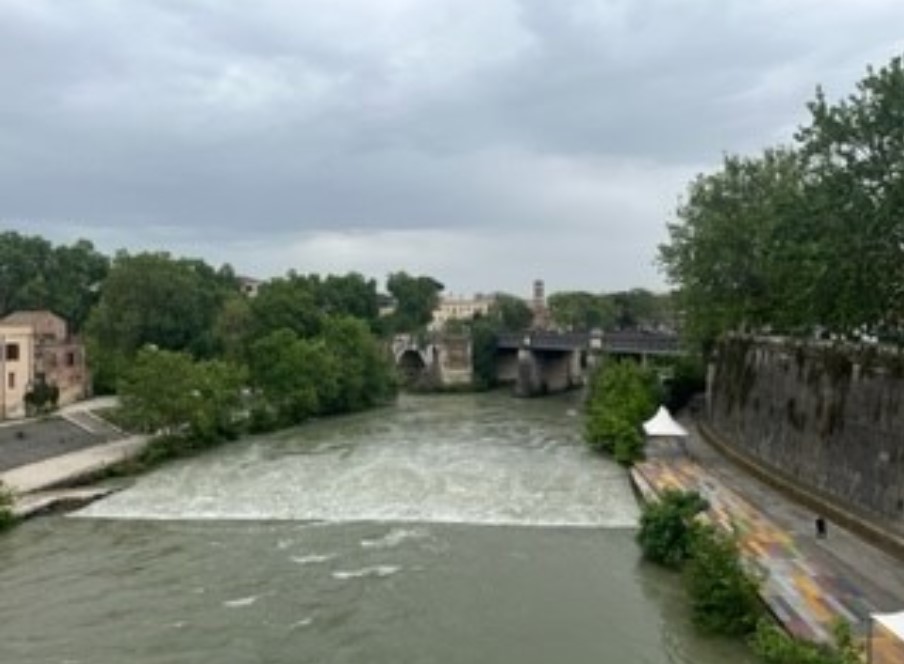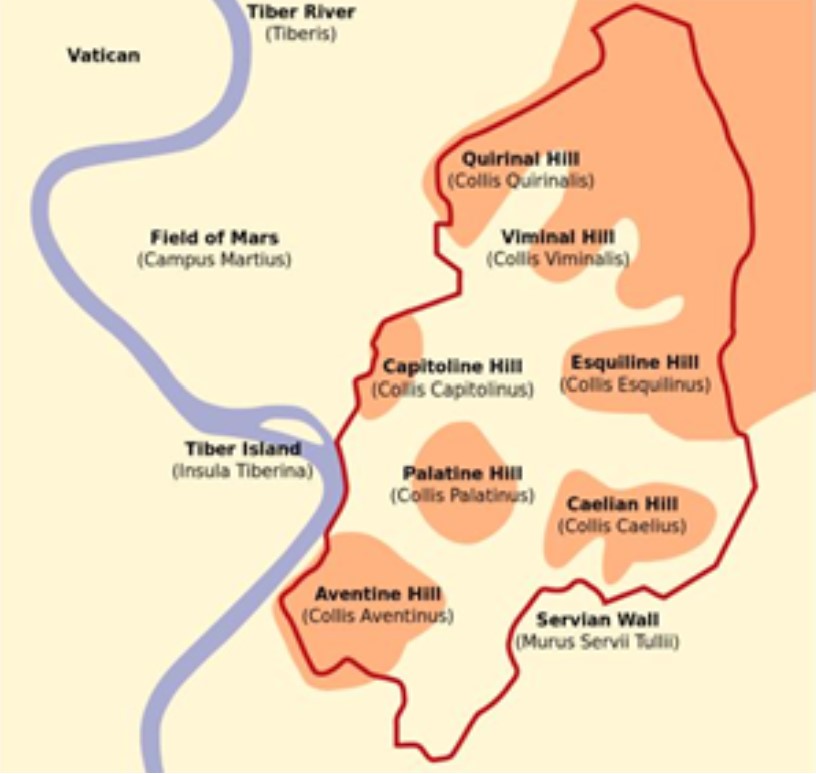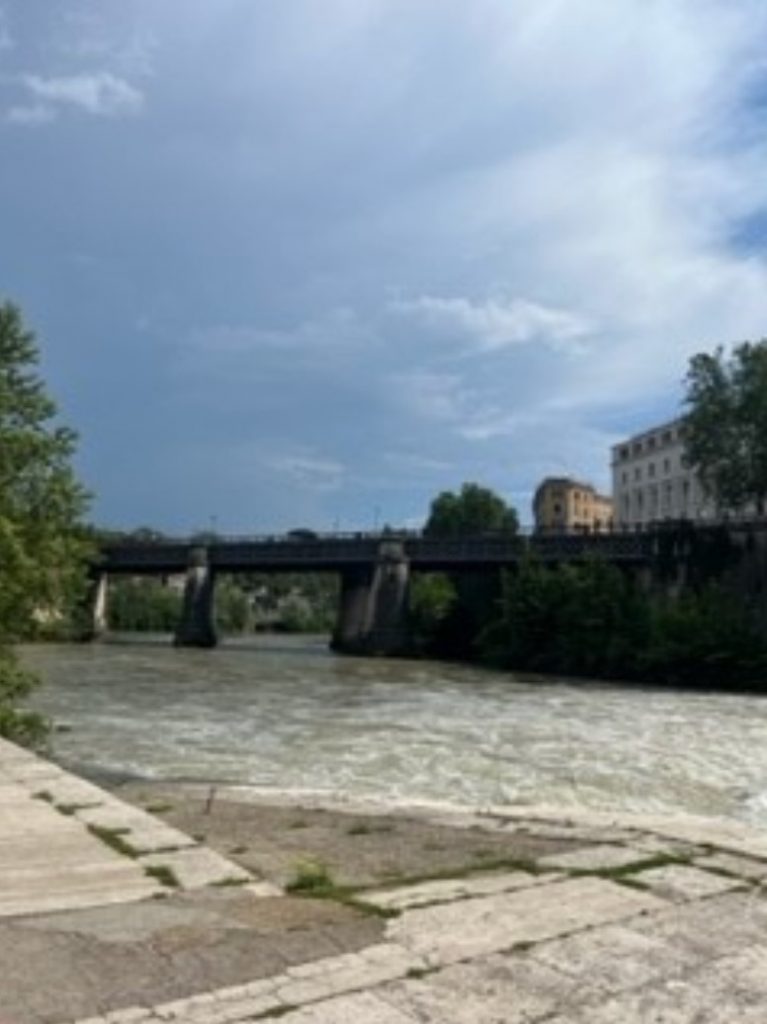Tags
BGSU History, BGSU Study Abroad, Casey Stark, Hope London, Italy, Jo Enger Arthur Scholarship for Study Abroad, Roma Aeterna, Rome, Tiber, Undergraduate
By: Hope London, BGSU Roma Aeterna Summer 2023 Student
HIST 3445: Ancient Rome, taught by Dr. Casey Stark, focused on the rise, and fall of the Roman Empire while studying abroad in Italy. For three weeks, we were centrally located in Rome and had the opportunity to learn more about Ancient Rome while seeing the history first-hand. During my time in Rome, I was able to learn more about the geography, important landmarks, and the layout of the city. Throughout this time, I saw how almost every large location was interconnected to something else or the role of religion and the God(s). Tiber Island was a location that we visited twice and passed several times while walking to other places in Rome. This island is near Trastevere and connected to the mainland of Rome through two bridges: Ponte Fabricio and Ponte Cestio. As we explored in our class, we learned more about how the original avoidance of the island drastically shifted during the plague of 293 BCE when Tiber Island became a center of medicine and religion, associations that the island continues to hold today.
The Tiber River is an important geographical feature that flows through Rome and empties into the Tyrrhenian Sea at Osita (Institute for Advanced Technology in the Humanities). This is important for how cities and towns began to populate around the Tiber River in order to sustain themselves. This was one of the main freshwater rivers that flowed near Rome and continuously supplied a drinkable water source for various needs. In Ancient Rome, the Tiber River was semi divided into what the upper and lower streams were used for; these included but were not limited to water for crops, home uses, sewer dumps, and eventually an expansion for waterway distributions (Rinne). These separations were important because if the sewer waste was dumped too far up the Tiber River, it would contaminate the ‘good’ water. Rome being adjacent to the Tiber River was vital to the transportation of goods and supplies, such as marble, in and out of the city (Strabo, Geography, 5.2). The use of the waterways allowed for easier and quicker transportation of materials, therefore allowing public projects to be completed quicker. Marble was frequently used for buildings because it was readily available, and not as valuable as it is in today’s market.
Tiber Island is the sole landmass located on the portion of Tiber River that runs through Rome. While studying abroad, some information I learned is that Tiber Island is roughly 890 feet long, 220 feet wide and was originally called “Insula Inter-Duos-Pontes” meaning “the island between two bridges”.While the original bridges have since deteriorated, reconstruction of the bridges have taken their place.Italy lies on the Eurasian tectonic plate, with a fault segment located near Tiber Island and plays an important role in how the island was formed. Scientists, using a digital elevation model (DEM), determined a tectonic displacement tilted a hanging wall; this shift caused a momentary dam to occur and caused the river to backflow and deposit sediment at what is now known as Tiber Island (Marra). While walking on Tiber Island, we were able to see how close the original height of the island was compared to the height of the Tiber River. The elevation difference had the constant issue of flooding and led to the island being built up over time. There are no mentions of Tiber Island prior to 509 BCE but there could be several reasons as to why, such as the destruction of historical documents, or the negative connotations of sickness and hostile individuals that frequented the land (Brucia). While it is unknown when the tectonic disruption occurred to create the large silt mount that later turned into an island, it is thought that this happened before 509 BCE. While we have the help of modern technology to help explain how Tiber Island came to be, Ancient Romans did not have this, but rather different origin stories to explain the creation of the island.
There are two main origin stories that were told about the formation of Tiber Island, but both are centered around strong emotions, such as anger or frustration, with the current Roman ruler. The first mythology of Tiber Island belongs to the 500s BCE after the death of tyrant Tarquinius Superbus. After his death, Romans threw his body into the Tiber River where silt and sediments accumulated on his body where it eventually formed Tiber Island. The second creation story of Tiber Island comes from the myth that Romans were upset with their ruler and to show their frustration, threw wheat and grain into the Tiber River (Brucia). The large amounts of resources thrown into the river created the foundation of Tiber Island. There are slight differences between the two stories, but they still share the same concept. The main creation story that is supported by Livy discussed the expulsion of the Tarquin family that led to the confiscation of their grain that could not be consumed by the Romans due to religiosum; these crops were believed to have belonged to the Gods, so they were dumped into the Tiber River, thus the creation of Tiber River in 509 BCE (Brucia). Livy’s interpretation is seen as one of the more accurate interpretations of the origin story for an ancient source. These mythologies were used as explanations because it helped connect Roman beliefs to their surroundings. While Tiber Island has its own mythology behind its creation, the island was avoided by the majority of Romans because it was deemed a location where the worst of criminals or contagious sick individuals were sent (Brucia). From a personal standpoint, there could be a tie behind the negative origin story of Tiber Island and the avoidance of it by most of the Roman population due to the negative connotations surrounding the land.
Tiber Island had constantly been avoided by Romans, with only the criminals and chronically sick individuals being sent to reside on the island. There is speculation that Tiber Island was left out of the emporium due to the religious reasons and the ties between the gods of the underworld and Tiber Island (Brucia). The Roman Gods and Goddesses played important roles in the lives of Romans. Each God had something they were deemed the ruler over, and this was no different for the Tiber River. Tiberinus was the god of the Tiber River and was considered one of the most important river gods because he found Romulus and Remus, the founders of Rome, floating down the river. It was important to appease the gods and goddesses to ensure they were happy. Maintaining a good relationship meant favorable events happened for the Romans; if the Gods were unhappy it would result in the Romans losing favor and being punished, with an example of this being the plague of 293 BCE. Prior to the plague, the Tiber River flooded and resulted in the destruction of bridges, homes, loss of lives, and individuals being blocked from their shops and chambers. These stressful conditions only worsened when a famine followed by the plague hit Rome. Military generals were originally preparing for campaigns when the plague hit; this put the plans on hold as the original paths were blocked and it was seen as an omen of impending danger (Tacitus, History, 1.86).
The focus of the Roman Senate also shifted on how to prevent any more loss of life and to stop the plague from spreading farther. The Roman Senate consulted the Sybil about a year later because the shift from war took time to change; this discussion helped discover the solution of building a temple for the Greek God of medicine and healing, Aesculapius (Livy, 10.47). Bringing Aesculapius to Rome meant there was a chance for Romans to survive the plague. A delegation was sent to Epidauros to obtain a statue of Aesculapius; upon picking up the statue and following the tradition, a snake from the temple was brought along, which immediately curled around the center mast of the ship. As we learned while in Rome, the snake got off the boat and swam to Tiber Island once the boat sailed farther down Tiber River; the Romans took the snake swimming to Tiber Island as a sign from Aesculapius that he wanted his temple built at that location. Shortly after, a temple in honor of Aesculapius was constructed and Tiber Island became a place for medicine and worship. As the island became well-known for the Temple of Aesculapius, there were features, such as designs to represent a ship, added to various parts of the island and buildings to show the connection between the arrival of Aesculapius, the method of transport, and the construction of the temple. The introduction of Aesculapius changed the view of Tiber Island from a place almost entirely devoid of life to a place that began to become frequently visited by Romans.

Tiber Island has since grown tremendously with a focus around medicine and religion. In 1584, a religious hospital was built and is still functioning today. This hospital is on the opposite side of Tiber Island where the original temple of Aesculapius was built, but still represents the focus of medicine and healing. The San Bartolomeo all’ Isola church was built on the original site of the temple and is the main church of Tiber Island. This church has undergone several renovations throughout history but still maintains its important standing within the culture. I was impressed by the history still present on Tiber Island and how populated the area is. I found it interesting that having two bridges connected to Tiber Island stayed consistent even with the renovations and reconstruction that occurred. This added to the historical significance of Tiber Island and showed the importance of maintaining the structures. This location has an interesting background to how the island came to be and the change of view after the plague that occurred in 293 BCE. Tiber Island is a great place to visit for individuals who love learning more about some of the oldest Ancient Roman sites.
Works Cited
Brucia, Margaret Angela. Tiber Island in Ancient and Medieval Rome. Fordham University
ProQuest Dissertations Publishing, 1990. https://www.proquest.com/docview/303843200?accountid=26417&parentSessionId=U%2BGo5EbQuwEoVjjIKhEm1WNnduuYAcdSVPzwfdE5Grw%3D&pq-origsite=summon
Institute for Advanced Technology in the Humanities. Tiber River. University of Virginia, 2008. http://archive1.village.virginia.edu/spw4s/RomanForum/GoogleEarth/AK_GE/AK_HTML/GF019.html#:~:text=The%20most%20important%20river%20in,mouths%E2%80%9D%20of%20the%20river).
Livy. “Book X., Chapter XLVII.” In The History of Rome.
Marra, Fabrizio. Rome in its setting. Post-glacial aggradation history of the Tiber River alluvial
deposits and tectonic origin of the Tiber Island. PLOS ONE, 2018 March 28.
https://www.ncbi.nlm.nih.gov/pmc/articles/PMC5874049/
Rinne, Katherine W. “Chapter 18 Renovatio Aquae: Aqueducts, Fountains, and the Tiber River in Early Modern Rome”. In A Companion to Early Modern Rome, 1492–1692. Leiden, The Netherlands: Brill, 2019. https://brill.com/display/book/9789004391963/BP000030.xml
Strabo. “BOOK V., CHAPTER II”. In Strabo, Geography. n.d. Www.perseus.tufts.edu.
http://www.perseus.tufts.edu/hopper/text?doc=Perseus:text:1999.01.0239:book=5:chapter=2&highlight=tiber%2Cisland.
Tacitus, Cornelius. “Book I., Chapter LXXXVI.” In The History.



